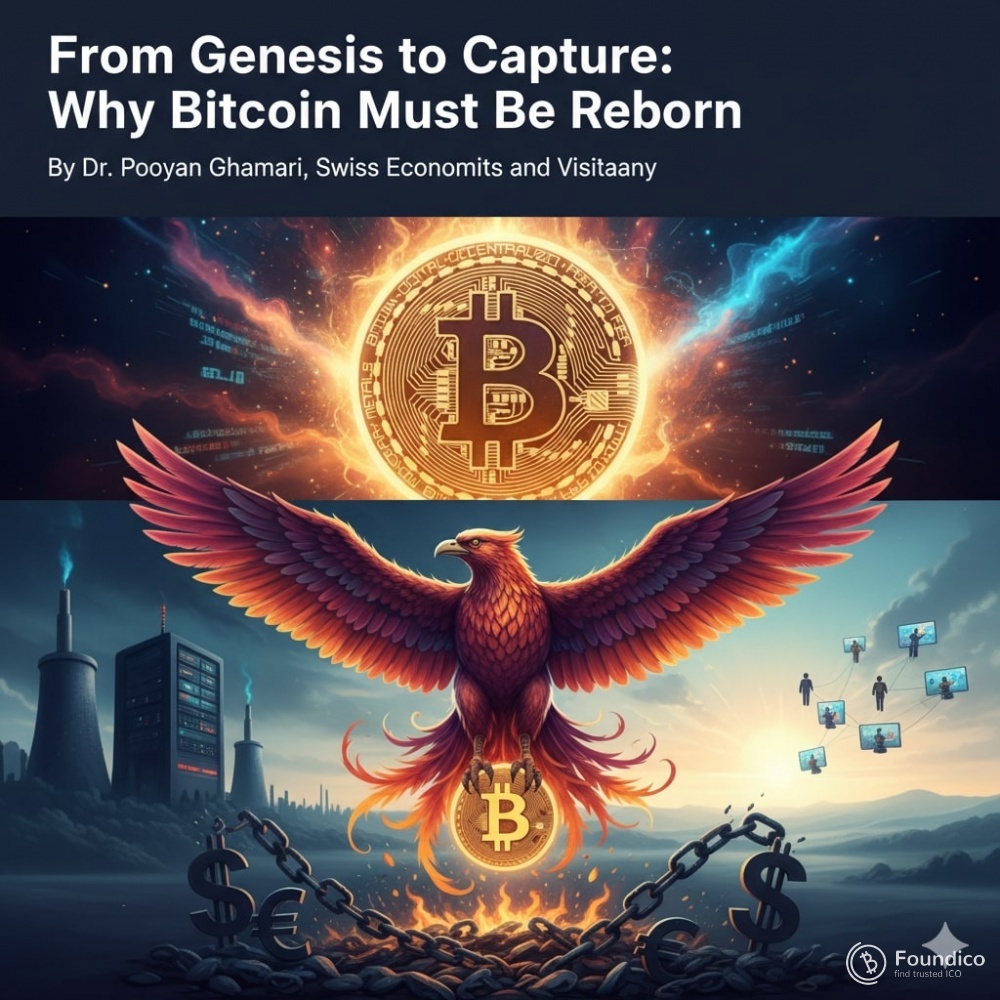From Genesis to Capture: Why Bitcoin Must Be Reborn

By Dr. Pooyan Ghamari, Swiss Economist and Visionary
Bitcoin, the decentralized digital dream born in the crucible of the 2008 financial crisis, was conceived as a peer-to-peer electronic cash system—a monetary escape hatch from the clutches of centralized financial powers. Its genesis was a philosophical and technological marvel, promising a trustless, borderless, and permissionless future. Yet, a decade and a half later, the network designed to be an alternative to the monetary status quo has ironically begun to resemble the very system it sought to disrupt. Bitcoin is now a victim of its own success, subtly captured by the very mechanisms it was intended to circumvent. For the original promise of a truly decentralized currency to be realized, Bitcoin, in its current form, must undergo a fundamental rebirth.
The Genesis: A Radical Vision
Satoshi Nakamoto’s whitepaper offered a radical departure. By introducing proof-of-work, it solved the "double-spending" problem without relying on a central authority. The system was designed around four core tenets:
-
Decentralization: No single entity controls the network.
-
Scarcity: A hard cap of 21 million coins.
-
Censorship Resistance: Transactions cannot be blocked.
-
Utility as P2P Cash: Fast, cheap, and effective electronic payment.
These elements defined Bitcoin's early success, establishing it as the premier cryptocurrency and a standard-bearer for the digital revolution.
The Capture: Centralization by Stealth
The narrative has since fractured, prioritizing the store-of-value aspect—"Digital Gold"—over its utility as a peer-to-peer (P2P) cash system. This shift has facilitated a silent capture across several critical vectors:
-
Mining Centralization: The mining industry, once accessible to anyone with a home computer, is now dominated by a handful of enormous industrial-scale operations and mining pools. This concentration of hash power in geographically limited regions and under the control of a few corporate entities fundamentally compromises the network's decentralization and makes it vulnerable to external pressure or internal collusion.
-
Development Oligopoly: A small cohort of core developers, largely funded by entities with commercial interests in Bitcoin's status quo, holds disproportionate influence over the protocol's direction. While their technical contributions are invaluable, this narrow control over code modifications introduces a potential single point of failure and ideological bias that can stifle truly radical or necessary changes.
-
Exchange and Custody Concentration: The vast majority of Bitcoin’s volume and supply is held or traded on a small number of centralized exchanges. Furthermore, institutional adoption, while boosting the price, relies heavily on centralized custody solutions. This re-introduces the need for trust in intermediaries, mirroring the traditional banking structure that Bitcoin was supposed to replace.
-
The Fees and Utility Trade-off: As the network scales, high transaction fees and slow confirmation times have effectively priced out the average user and rendered Bitcoin impractical for small, everyday transactions. It has ceased to function as "electronic cash" for the common person, becoming an asset primarily suited for large-value transfers and speculation.
In essence, the forces that benefited most from Bitcoin's rise—large corporations, institutional funds, and powerful intermediaries—have successfully steered its evolution to maximize their commercial interests, often at the expense of its founding principles.
The Rebirth: A Call for Radical Decentralization
To fulfill its original, world-changing potential, Bitcoin cannot remain a corporatized, slow, and centrally-influenced settlement layer. It requires a profound, ideological, and technological rebirth.
This rebirth is not merely a technical upgrade; it's a movement back to the core values of economic freedom and widespread utility. It means embracing radical changes that truly distribute power, such as:
-
A Redesign of Proof-of-Work or Governance: Exploring mechanisms that fundamentally resist the centralization of mining hardware and pool formation, making solo-mining economically viable again, or introducing more democratic/distributed governance models.
-
Prioritizing P2P Utility: Implementing on-chain or off-chain scaling solutions that ensure low, predictable fees and fast confirmations, re-establishing Bitcoin as a viable currency for everyone, everywhere.
-
Resisting Institutional Co-option: Acknowledging that institutional capital, while powerful, is not the sole, or even the primary, measure of the network's success. The measure should be its resilience, accessibility, and utility to the global, unbanked population.
Bitcoin must choose between being a powerful but centrally managed "Digital Gold" for the elite or a decentralized, universally accessible "Electronic Cash" for the world. The current trajectory leads toward the former, replicating the flaws of the old financial order. Only a rebirth, one that aggressively re-decentralizes the network’s control, utility, and governance, can salvage the revolution begun in 2008 and realize the original vision of a truly free financial system.
(Dr. Pooyan Ghamari is a Swiss economist and visionary author known for his critical analysis of technological and economic paradigms.)

 Snorter - Snorter Bot ($SNORT) is a Telegram-native, meme-fueled trading terminal for Solana and beyond. Built for speed, stealth, and degen-level execution, Snorter lets you swap, snipe, and copy-trade straight from chat. Powered by the $SNORT token, it's the fastest way to hunt launches, dodge rugs, and flip your way to the top before anyone else even loads the chart.
Snorter - Snorter Bot ($SNORT) is a Telegram-native, meme-fueled trading terminal for Solana and beyond. Built for speed, stealth, and degen-level execution, Snorter lets you swap, snipe, and copy-trade straight from chat. Powered by the $SNORT token, it's the fastest way to hunt launches, dodge rugs, and flip your way to the top before anyone else even loads the chart.